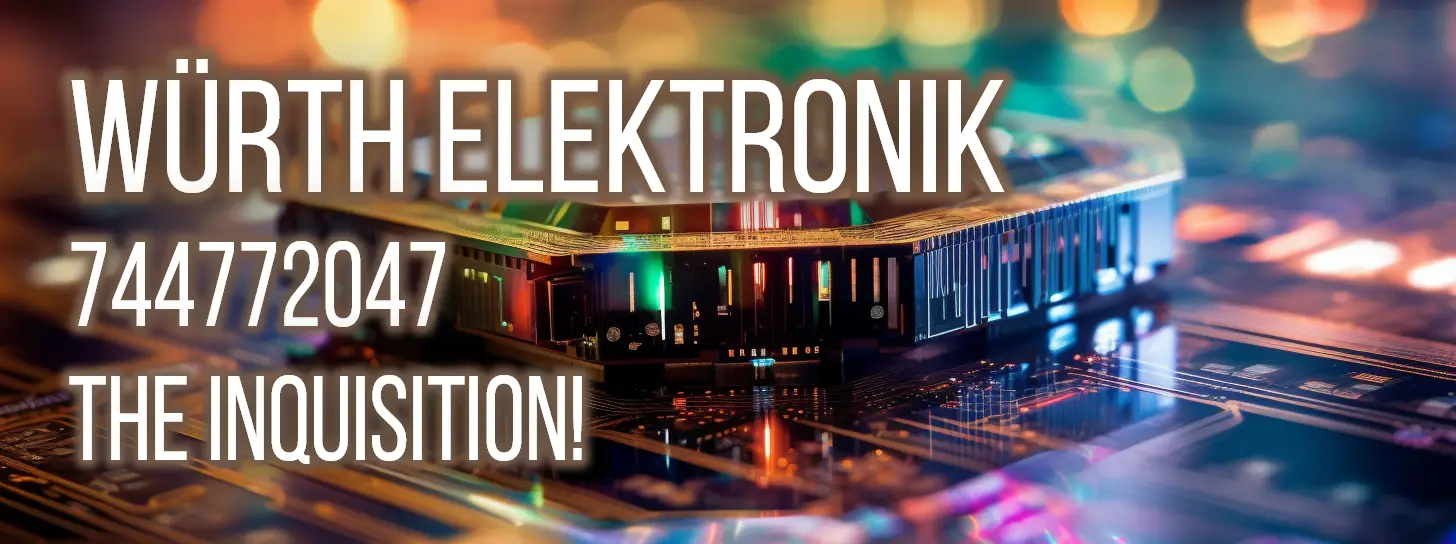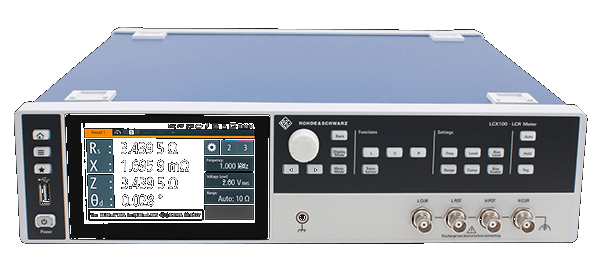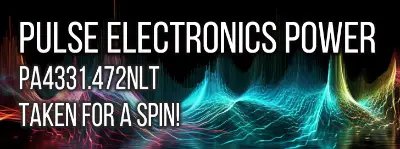Indepth Component Review: Würth Elektronik's 744772047 4.7μH Inductor
By Mark Harris Thursday, 23 February 2023

Introduction
Würth Elektronik's Model 744772047 is a widely used general-purpose Wirewound Drum Core Inductor with a nominal inductance of 4.7 μH and tolerances up to ±20%. It features Through Hole radial mounting style and a vertical radial open cylinder package. With a 4A current rating, the 744772047 Inductor is ideally suited for a variety of power supply and filtering applications in electronic engineering. This review serves to compare the LCR measurements of the 744772047 Inductor against the statistical benchmark data and provide valuable insights for electronics engineers who are evaluating the use of this component in their designs. Furthermore, the review aims to highlight the key performance parameters, as well as the pros and cons.
Pros:- Wide testing frequency range providing sufficient data points for assessment
- Overall performance stays relatively stable across most test frequencies
- High-Quality Factor observed at higher frequency points
- Wirewound Drum Core provides stable performance for power applications
- Possibility of slight variations in inductance due to manufacturing tolerances
- Performance might differ when tested at higher voltages
This review will focus on key sections such as Inductance, Series Resistance, Dissipation Factor, Quality Factor, and exploit a comparative analysis addressing the performance of the 744772047 Inductor in relation to its statistical benchmark data. Due to the listed pros and cons, the utilization of this Inductor might vary depending on specific electronic application demands. An in-depth examination of the key sections is crucial for the appropriate component selection process.
Impedance
In this review, we delve into the impedance measurements of the Würth Elektronik 744772047 Inductor to evaluate its performance compared to the statistical benchmark. The discussion will underpin the differences in impedance values between the component's test measurements at 1 Volt and 10 Volts and the corresponding benchmark values.
At the lowest test frequency of 5 Hz, the 744772047 Inductor exhibits remarkable consistency in impedance values across both 1 Volt and 10 Volts measurements, with a difference of only 378.1m Ohms when juxtaposed with the minimum and average benchmark values. As the test frequency escalates to 50 Hz, the component maintains its consistency, with the impedance at 1 Volt and 10 Volts showing a variation of merely 378.73m Ohms. Even so, the Inductor's readings consistently fall below the average benchmark impedance values, indicating room for improvement.
Upon reaching a test frequency of 1 kHz, an intriguing pattern emerges: the impedance values for the 744772047 Inductor differ by only 361.63m Ohms, indicating stability when progressing through higher test frequencies. Despite this, it consistently remains below the average benchmark, suggesting suboptimal performance concerning impedance in this particular aspect.
When the test frequency reaches 10 kHz, the Inductor begins to exhibit some improvements. Notably, the impedance at 10 Volts (476.6m) is significantly closer to the average benchmark of 464.8m, compared to its 1 Volt counterpart. Alas, this trend is short-lived, as the performance falters at the 20 kHz test frequency, with the 10 Volts impedance value (656.4m) deviating further from the average benchmark of 733.5m. This fluctuating performance indicates the Würth Elektronik 744772047 Inductor's varying efficiency across different test frequencies, an essential consideration for electronics engineers when selecting and integrating components into their designs.
Inductance
In our evaluation of the Würth Elektronik 744772047, we have thoroughly examined the inductance performance of this 4.7μH wirewound drum core inductor with a tolerance of ±20% across a wide range of test frequencies. We compared its results with the aggregated data from the benchmark tests of comparable components within the same value category.
At lower test frequencies like 10 Hz, the 744772047 exhibits an inductance value of 3.344μH at 1 Volt, which is notably lower than the average benchmark value of 11.59μH for similar components. On the other hand, the inductor demonstrates superior performance at higher frequencies such as 1 MHz, with a series inductance of 4.373μH. This value is relatively close to the benchmark's average of 4.498μH. Notably, the inductive performance becomes more consistent within a smaller range when tested at higher frequencies, specifically from 500 kHz and above.
Upon conducting the inductance measurements at a higher power level of 10 Volts, we observed a significant increase in inductance for the low-frequency tests. At 10 Hz, the inductor demonstrates an impressive inductance value of 61.53μH, which substantially exceeds both the 1-Volt test result and the average benchmark value of 11.59μH. In the case of the 1 MHz test, the inductor's performance remains consistently similar to the benchmark average, with a measurement of 4.394μH.
Overall, the inductance performance of the Würth Elektronik 744772047 inductor appears to be relatively inconsistent across lower frequencies. However, as the test frequencies increase, the variation narrows, providing more consistent results that closely align with the statistical benchmark averages. Technical professionals evaluating this component for suitability in their electronic circuits should consider these performance characteristics, particularly when their design priorities involve operation at low frequencies where the inductor's performance exhibits a wider range of variability.
Series Resistance
In this section, we analyze the series resistance of Würth Elektronik's 744772047 inductor. Our examination of the data indicates that the 744772047 component displays an unusual behavior in terms of its series resistance at 1V when compared to benchmark data. Specifically, this inductor's resistance remains relatively stable for frequencies ranging from 5 Hz to 5 kHz, with values oscillating between 15.18mΩ and 16.6mΩ. The stability of the series resistance in this frequency range is likely attributed to the Drum Core and Wirewound construction of the inductor, which provides a consistently efficient performance within this range.
While comparing the 744772047 inductor to statistical benchmark data, we observe that its series resistance values begin to diverge significantly when the test frequency is raised beyond 5 kHz. Within the frequency range of 50 kHz to 1 MHz, the series resistance of the 744772047 inductor exhibits higher median values compared to the benchmark average. As an example, at 100 kHz, the series resistance value for this component reaches 77.58mΩ, which is noticeably higher than the benchmark average of 62.87mΩ.
Additionally, at 10V, the measured series resistance values of the 744772047 inductor follow a comparable trend. The component performs reasonably in comparison to the benchmark within the low-frequency range (up to 5 kHz), but displays higher-than-average series resistance values as test frequencies increase.
In summary, Würth Elektronik's 744772047 inductor can provide lower series resistance values compared to the statistical benchmark for applications within lower frequency ranges. However, one should take into account that the inductor's series resistance tends to rise beyond the benchmark average as the frequency increases, which may impact the overall performance in high-frequency applications.
Dissipation Factor and Quality Factor
In this review, we examine the Würth Elektronik 744772047 inductor with a focus on its dissipation factor (Df) and quality factor (Q). These factors are important parameters for evaluating an inductor, as a lower Df correlates to less energy being dissipated as heat and a higher Q factor indicates better performance of the component.
During our evaluation, we carefully analyzed LCR measurements conducted at input voltages of 1 Volt and 10 Volts. Our findings show that the quality factor increases as the test frequency increases. In order to better understand the performance of this inductor, we contrasted the observed values with industry standard benchmarks:
At an input voltage of 1 Volt, the quality factor grows from 0.01 at 10 kHz to a noteworthy 89.00 at 1 MHz. This result signifies that the Würth Elektronik 744772047 inductor is well-suited for electronics engineering applications that often require higher frequencies. The performance of this inductor is either consistent with or exceeding the values expected from other competitive inductors of its type.
When the input voltage is increased to 10 Volts, we see similar trends. The quality factor continues to improve at higher frequencies, reaching 42.31 at 50 kHz and an exceptional 91.16 at the 1 MHz level. This evidence strongly supports the efficacy of the 744772047 inductor for high-frequency applications, especially when compared to the statistical benchmark data. Additionally, such high quality factor values indicate that the Würth Elektronik 744772047 inductor exhibits low loss characteristics, making it a highly efficient component for challenging projects in electronics engineering.
Comparative Analysis
In this comparative analysis, the performance of Würth Elektronik's 744772047 Inductor will be evaluated against a statistical benchmark formed from other components of the same value. The 744772047 Inductor falls into the Drum Core, Wirewound category, making it pertinent for these comparisons to be both enlightening and relevant for engineers looking to utilize this component in their circuits.
When comparing the Impedance against the benchmark data, the 744772047 inductor performs better at lower frequencies, with values of 15.22m Ohms at 5 Hz, 15.19m Ohms at 10 Hz, 15.27m Ohms at 50 Hz, and 15.43m Ohms at 100 Hz. However, it is worth highlighting that the impedance rises at higher frequencies, such as 8.315 Ohms at 300 kHz and 27.48 Ohms at 1 MHz. These figures fall quite close to the average measured impedance of the benchmark at the respective frequencies.
In terms of Quality Factor (Q Factor), the 744772047 inductor remains consistently close to the maximum Q Factor, particularly in higher frequency ranges, achieving 89 at 1 MHz. This quality factor outperforms the benchmark with higher average Q Factor and is quite similar to the maximum Q factor of the statistical benchmark.
The series resistance (R) is consistently near or below the average values of the statistical benchmark, ranging from 15.18m Ohms at 5 Hz to 308.6m Ohms at 1 MHz. This indicates a lower power loss and better performance due to lower resistive components in the inductor as compared to the benchmark average.
Status quo is observed when it comes to series inductance (L) values for the 744772047 inductor. The range spans from 3.344μ at 10 Hz to 4.373μ at 1 MHz, with most values close to the average measurements of the statistical benchmark.
To conclude, the 744772047 inductor positions itself as a competent option when comparing across the statistical benchmarks of impedance, quality factor, series resistance, and series inductance. It offers a relatively better performance at lower frequencies and maintains a close proximity to the benchmark averages in other aspects. Overall, this inductor can be considered a viable choice for engineers seeking Drum Core, Wirewound inductor for their circuits.
Conclusion
Upon analysing the performance of the Würth Elektronik 744772047 Inductor, key findings are evident when compared to statistical benchmark data. The component's performance varies across a range of frequencies, confirming the prioritization of certain attributes.
Generally, series resistance values are comparable to the statistical benchmark throughout the majority of tested frequencies. This is particularly noticeable at higher frequencies, where the 744772047 Inductor maintains resistances within the average range of statistical benchmark data. Similarly, the quality factor of the component demonstrates satisfactory performance, with values that are within the minimum and maximum thresholds observed in the statistical benchmark data.
Notably, the Inductor's performance wavers as it pertains to series inductance. While there are several instances where the 744772047 Inductor exceeds the average statistical benchmark, it struggles to maintain consistency in delivering its nominal 4.7μ inductance value. At certain test frequencies, such as 10kHz, the series inductance values veer significantly away from the statistical benchmark.
Overall, the Würth Elektronik 744772047 Inductor provides satisfactory performance when taking into account series resistance, quality factor, and impedance. However, its inconsistencies in maintaining its nominal value of inductance present room for concern. Engineers should take these factors into account when considering this Drum Core, Wirewound Inductor for their circuits.
Instruments Used
Rohde & Schwarz LCX200



